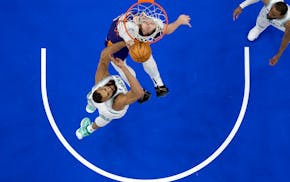Vikings fans might disagree based on the gaping hole that sunk their team this season, but ESPN analyst Trent Dilfer calls this, "the golden age of quarterbacking."
He doesn't care that Hall of Famer Steve Young and his other buddies at ESPN laugh at him when he says things like that. Or when they needle him for it after, say, an Andy Dalton opens the playoffs with a colossal stinker for the third consecutive year.
In Dilfer's opinion, the league has always had its upper crust of quarterbacks. The "Mount Rushmore guys," as he calls them, the "Tom Brady, Peyton Manning, Aaron Rodgers and Drew Brees" types.
"But," he adds, "I think it's the second tier that makes this the golden age."
Guys such as Philip Rivers, Andrew Luck, Colin Kaepernick, Russell Wilson and Cam Newton. That's five examples right there from the deeper second tier that's more than capable of toppling the Mount Rushmore types. In fact, Kaepernick's 49ers have now done it to Rodgers' Packers in back-to-back postseasons.
"That second-tier group is 10, 12, 14 deep of guys who can really, really play," Dilfer said. "And they can handle so much."
That's one big reason this weekend's divisional playoff matchups are so interesting. A smorgasbord of contrasting styles, ages and eras will be spread over two days in four games featuring old future Hall of Famers, young future All-Pros, or both.
Saturday opens with the 33-year-old, 6-foot Brees leading his Saints into Seattle to face the league's best defense and the 25-year-old, 5-11 Wilson. The day ends with the up-and-coming Colts and 24-year-old Luck visiting the Patriots, where coach Bill Belichick and the 35-year-old Brady have been together since Luck was 10 years old.
Sunday begins with an ode to the Next Generation — the 26-year-old Kaepernick in Carolina for the 24-year-old Newton's playoff debut — and ends with a throwback to the Pocket Passing Generation — the 31-year-old Rivers and his surging Chargers in Denver to face the 36-year-old soon-to-be five-time MVP Manning.
When Dilfer, a former 14-year quarterback who won a Super Bowl with the Ravens, talks about the quarterbacks featured in the divisional playoff round, nearly everything he masterfully articulates illustrates why these eight teams are still alive and why the Vikings are likely to stay dead until they find the right quarterback to lead them.
Two examples:
'Plays After Critical Errors'
"PACE," or Plays After Critical Errors, an acronym Dilfer said he created, is, according to Dilfer, "the best way to evaluate quarterbacks."
Perfect and most recent example: Luck orchestrating the second-largest come-from-behind victory (28 points) in playoff history against the Chiefs last week.
After Luck threw his third interception to put the Colts down 41-24 with 19 minutes left, he proceeded to complete 10 of 14 passes for 201 yards and two touchdowns while running three times for 22 yards and a touchdown.
"[PACE] is Andrew's greatest asset," Dilfer said. "He just has an amazing mind and an amazing soul to go along with a whole bunch of talent."
'Physical confidence'
Dilfer evaluates close to 1,000 premier prep quarterbacks every spring as part of his coaching role in the Elite 11 national quarterback competition. He says matchups such as the Kaepernick-Newton one on Sunday could be commonplace as the young, big-bodied elite athletes now playing quarterback at the grass roots level continue to matriculate to the college and pro levels through the advanced mental and physical training programs that are available to today's kids.
"You're seeing a trend," he said. "The biggest, baddest dude is no longer playing wide receiver or tight end or defensive end. He's playing quarterback. And they're everywhere."
Although it's not a trait limited to quarterbacks of that size and athleticism, Dilfer said he's noticing more young players playing with what he calls "physical confidence."
"They extend the play just because of the confidence in their ability not to get tackled, a la Ben Roethlisberger," Dilfer said. "And you don't have to be 6-4, 6-5 and 250 pounds to play with it. Russell Wilson is a guy who plays with it."
Unfortunately, the NFL doesn't have 32 of them.
"When you watch the ones who have it and then look at the quarterback who doesn't have that, the difference is amazing," Dilfer said. "You see how the ones who don't have it have to play on rhythm and timing all the time because if things aren't perfect, they go to the ground or they get taken down by a sleeve or they get bumped off their spot and they can't complete the ball."
That does sound familiar.
Mark Craig mark.craig@startribune.com

Reusse: How bad are the White Sox? They made Twins look good.
NFL draft has been on tour for a decade and the next stop is Detroit, giving it a shot in spotlight

Souhan: Wolves fans made Game 1 special. Now bring on Game 2.

Will Wolves show best-in-the-NBA defensive form in Game 2?

